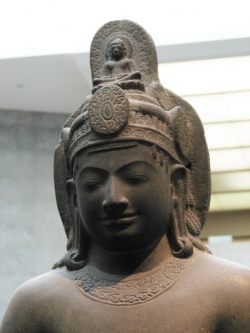Difference between revisions of "Lakṣaṇa"
| Line 2: | Line 2: | ||
<poem> | <poem> | ||
[[lakṣaṇa]] | [[lakṣaṇa]] | ||
| − | ([[Sanskrit]], mark). Term used mainly in [[Buddhist]] {{Wiki|scholasticism}} ([[Abhidharma]]) to denote the specific identifying attribute or defining [[characteristic]] of an [[entity]]. As an example, all {{Wiki|phemomena}} ([[dharma]]) are said to bear the three ‘marks’ of [[impermanence]] ([[anitya]]), [[suffering]] ([[duḥkha]]), and [[no-self]] ([[anātman]]). In [[Abhidharma]] tabulations, various defining [[characteristics]] were identified for different [[phenomena]], such as heat as the defining [[characteristic]] of [[fire]], or {{Wiki|hardness}} as that of [[earth]]. In some [[Mahāyāna]] sources the [[lakṣana]] of a thing came to be defined as that [[mental]] {{Wiki|concept}} ([[vikalpa]]) by which one [[knows]], defines, and [[understands]] an [[object]] which has a particular {{Wiki|perceptual}} [[form]] ([[nimitta]]), such as being of a particular {{Wiki|colour}}, and so forth. | + | ([[Sanskrit]], mark). Term used mainly in [[Buddhist]] {{Wiki|scholasticism}} ([[Abhidharma]]) to denote the specific identifying attribute or defining [[characteristic]] of an [[entity]]. |
| + | |||
| + | As an example, all {{Wiki|phemomena}} ([[dharma]]) are said to bear the three ‘marks’ of [[impermanence]] ([[anitya]]), [[suffering]] ([[duḥkha]]), and [[no-self]] ([[anātman]]). | ||
| + | |||
| + | In [[Abhidharma]] tabulations, various defining [[characteristics]] were identified for different [[phenomena]], such as heat as the defining [[characteristic]] of [[fire]], or {{Wiki|hardness}} as that of [[earth]]. | ||
| + | |||
| + | In some [[Mahāyāna]] sources the [[lakṣana]] of a thing came to be defined as that [[mental]] {{Wiki|concept}} ([[vikalpa]]) by which one [[knows]], defines, and [[understands]] an [[object]] which has a particular {{Wiki|perceptual}} [[form]] ([[nimitta]]), such as being of a particular {{Wiki|colour}}, and so forth. | ||
| + | |||
[[lakṣaṇa]] mfn. indicating, expressing indirectly {{Wiki|Vedântas}}. | [[lakṣaṇa]] mfn. indicating, expressing indirectly {{Wiki|Vedântas}}. | ||
| + | |||
| + | |||
• m. Ardea Sibirica L. | • m. Ardea Sibirica L. | ||
| − | • N. of a man Rājat. (often confounded with, lakṣmaṇa) | + | • N. of a man Rājat. (often confounded with, [[lakṣmaṇa]]) |
• (ā), f. s.v | • (ā), f. s.v | ||
• n. (ifc. f. ā) a mark, [[sign]], [[symbol]], token, [[characteristic]], attribute, [[quality]] (ifc. = 'marked or characterized by', 'possessed of') Mn. MBh. &c | • n. (ifc. f. ā) a mark, [[sign]], [[symbol]], token, [[characteristic]], attribute, [[quality]] (ifc. = 'marked or characterized by', 'possessed of') Mn. MBh. &c | ||
| + | |||
• a stroke, line (esp. those drawn on the sacrificial ground) ŚBr. GṛŚrS. | • a stroke, line (esp. those drawn on the sacrificial ground) ŚBr. GṛŚrS. | ||
• a [[lucky]] mark, [[favourable]] sign GṛŚrS. Mn. MBh. &c | • a [[lucky]] mark, [[favourable]] sign GṛŚrS. Mn. MBh. &c | ||
Latest revision as of 20:05, 7 December 2015
lakṣaṇa
(Sanskrit, mark). Term used mainly in Buddhist scholasticism (Abhidharma) to denote the specific identifying attribute or defining characteristic of an entity.
As an example, all phemomena (dharma) are said to bear the three ‘marks’ of impermanence (anitya), suffering (duḥkha), and no-self (anātman).
In Abhidharma tabulations, various defining characteristics were identified for different phenomena, such as heat as the defining characteristic of fire, or hardness as that of earth.
In some Mahāyāna sources the lakṣana of a thing came to be defined as that mental concept (vikalpa) by which one knows, defines, and understands an object which has a particular perceptual form (nimitta), such as being of a particular colour, and so forth.
lakṣaṇa mfn. indicating, expressing indirectly Vedântas.
• m. Ardea Sibirica L.
• N. of a man Rājat. (often confounded with, lakṣmaṇa)
• (ā), f. s.v
• n. (ifc. f. ā) a mark, sign, symbol, token, characteristic, attribute, quality (ifc. = 'marked or characterized by', 'possessed of') Mn. MBh. &c
• a stroke, line (esp. those drawn on the sacrificial ground) ŚBr. GṛŚrS.
• a lucky mark, favourable sign GṛŚrS. Mn. MBh. &c
• a symptom or indication of disease, Cat
• a sexual organ MBh. xiii, 2303
• a spoon (?) Divyâv.
• accurate description, definition, illustration Mn. Sarvad. Suśr.
• settled rate, fixed tariff Mn. viii, 406
• a designation, appellation, name (ifc. = 'named', 'called') Mn. MBh. Kāv.
• a form, species, kind, sort (ifc.= 'taking the form of', 'appearing as') Mn. Śaṃk. BhP.
• the act of aiming at, aim, goal, scope, object (ifc. = 'concerning', 'relating to', 'coming within the scope of') APrāt. Yājñ. MBh. BhP.
• reference, quotation Pāṇ. 1-4, 84
• effect, operation, influence ib. i, 1, 62 &c
• cause, occasion, opportunity R. Daś.
• observation, sight, seeing W.
lakṣaṇa: Characteristic.
